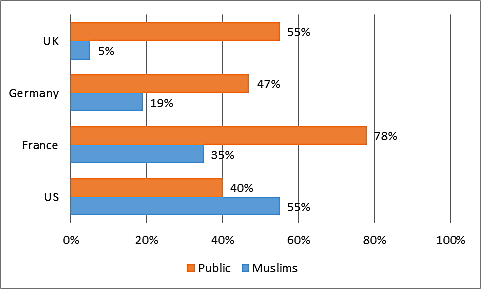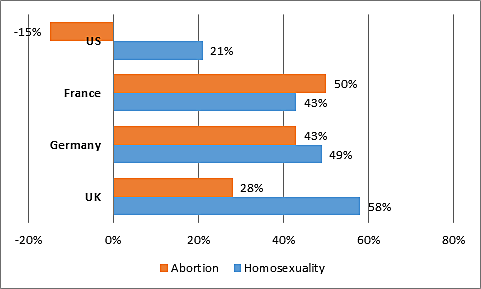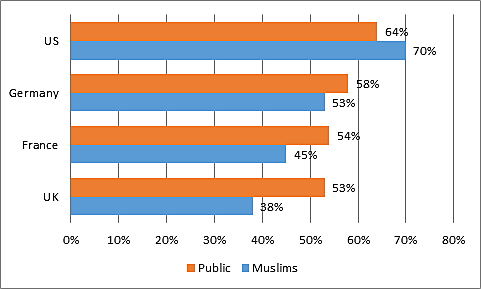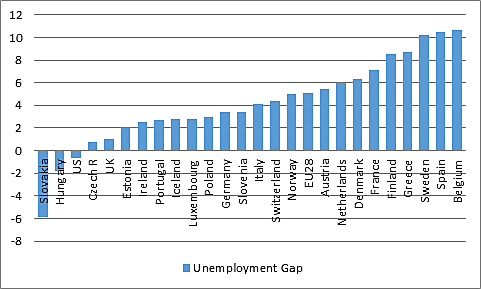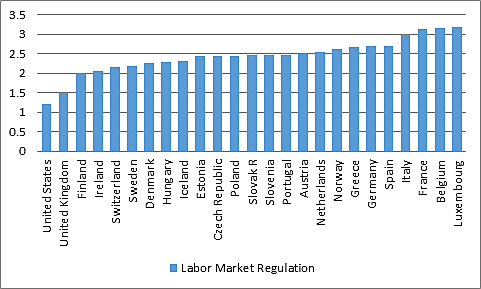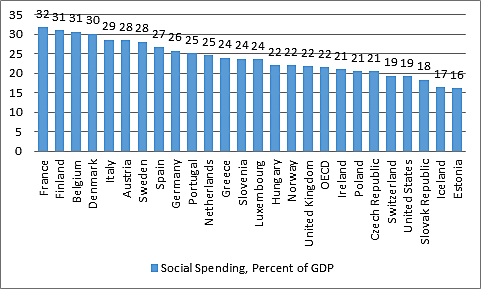Muslim immigrant assimilation in the United States is proceeding well. American Muslims have either similar or greater socio-economic status and levels of education than the average American. They are also active in civil and political society. However, this is not the case in Europe where Muslim immigrants tend to have worse labor market outcomes, are less well educated, and less socially integrated. The lack of assimilation and integration in Europe is affected by policies regarding multiculturalism, welfare, labor market regulation, citizenship, and guest worker laws that make integration more costly.
Integration in Europe
Social opinions show how Muslims in Europe are less integrated than in the United States. In Europe, there is a wide gap between Muslim and non-Muslim acceptance of homosexuality (Figure 1) and abortion (Figure 2) according to three surveys published in 2007 and 2009. The acceptance gap on these issues is the smallest in the United States – meaning that Muslims in the United States have opinions that are closer to the general public than in European countries (Figure 3).
Figure 1
Is Homosexuality Morally Acceptable?
Sources: Pew and Gallup.
Figure 2
Is Abortion Morally Acceptable?
Sources: Pew and Gallup.
Figure 3
Acceptance Gap
Sources: Pew and Gallup.
Opinions on social issues are just one aspect of this gap in assimilation but an important one for judging how assimilated immigrants are into Western culture. Although there are many other areas that could be compared, opinions of abortion and homosexuality show that Muslim Europeans are less well-assimilated than Muslims in the United States.
Labor Markets
In Europe, Muslims were less likely to have a job than non-Muslims in 2009, while they were more likely to have one in the United States (Figure 4).
Figure 4
Do You Have a Job?
Source: Gallup.
Immigrants in Europe are more likely to be unemployed than natives in every country except Hungary and Slovakia. Figure 5 shows the gap in native-born and Muslim unemployment. In the United States, immigrants have a lower unemployment rate than natives. However, in most European countries the unemployment rate for immigrants is far above that of natives – by almost 11 percentage points in Belgium.
Figure 5
Unemployment Gap between Immigrants and Natives
Source: OECD.
Virtually all Muslims in Western Europe are immigrants or the descendants of recent immigrants from outside of the EU. The employment gap, measured by subtracting the non-EU immigrant employment rate from the EU-15 employment rate, shows an even wider gap for the predominantly Muslim immigrants (Figure 6). There are other immigrants in Europe from outside of the EU that are included in this figure.
Figure 6
Employment Gap between Non-EU Immigrants and Native-EU Citizens, 2015
Source: OECD.
Figure 7 addresses that problem by showing that immigrants to the EU-OECD from the Middle East and North Africa, who are predominately Muslim, fare the worst in the labor market. European labor market controls and regulations explain the differences between American and European outcomes.
Labor market regulations make it expensive for firms to hire new workers, incentivizing employers to hire workers they know and are familiar with. Since immigrants are some of the most unfamiliar workers in any labor market, regulations in Europe result in lower employment rates for Muslim immigrants. There is empirical literature documenting their relatively poor labor market integration going back decades (Kogan, 2004; Fleischmann and Dronkers, 2010; Kogan, 2010). Less employment means less hope for the future, fewer opportunities for integration, and a general sense of unease in their new societies. European labor market regulations are crushing job opportunities for Muslim immigrants and their descendants.
Figure 7
EU-OECD Unemployment Rate by Region of Origin, 2015
Source: OECD.
A plethora of rules across countries, from minimum wages to collective bargaining to severe punishments for firing employees, all increase the cost of hiring workers (OECD EPL Database, 2013). In France, employees must be rehired if they were fired unfairly, which includes cases where the firing was done to “save money or boost profits.” In these inflexible labor markets, firms have an incentive to keep their workforces small and to entrust responsibilities to experienced employees rather than to hire unknown or unproven job seekers who are more likely to be immigrants.
Muslim immigrant workers are generally less skilled and productive than European workers, meaning they earn a lower wage, but minimum wages prevent such legal bidding down. Labor market regulations are categorized and ranked by the OECD on a 0 to 6 scale ranging from no labor market protections to total government control. Averaging the categories shows that the United States’ labor market is significantly less regulated than Europe (Figure 8). This explains part of the employment and unemployment gap between Muslim immigrant and native Europeans.
Figure 8
Labor Market Regulations
Source: OECD.
Baked into the OECD labor market regulations are rules to protect trade unions, which are more powerful in most European countries than in the United States (Bisin et al., 2011). Unions exist to raise the wages of their members by decreasing the supply of labor available to employers. Immigrants increase the supply of labor so unions favor rules that exclude them from employment, benefiting the economic “insiders” who already have union jobs at the expense of the “outsiders” who are more likely to be Muslim immigrants (Lindbeck and Snower, 2001).
The empirical literature supports the theory that inflexible labor markets disproportionately harm the employment prospects of immigrants. Bisin et al. (2011) find a statistically robust negative relationship between trade union density and the immigrant employment rate. They also find some evidence that employment protections and minimum wages reduce immigrant employment. Kogan (2006) finds that “liberal welfare regimes” with decentralized industrial-labor relations and high labor market flexibility lead to better employment outcomes for male immigrants. Gebel and Giesecke (2011) add that extensive employment protections for permanent workers increase both unemployment for low-skilled workers as well as the incidence of temporary contracts between employers and low-skilled workers.
The United States is the least regulated labor market among the developed countries analyzed (Figure 8). American labor markets are much less rigid than their European counterparts and thus significantly less likely to disadvantage immigrants in employment, Muslim or otherwise. This partially explains the higher employment of immigrants in the U.S. labor market (Figure 5) and the higher rate of Muslim employment in the U.S. relative to the general public (Figure 4).
Welfare
Many European countries have generous welfare states that provide extensive aid to the poor, including immigrants. This creates two significant obstacles to integration. The first is that welfare programs reduce the incentive to work. Work provides useful skills and experience, facilitates social relationships and cultural understanding, provides an incentive to learn the language and culture of the new country, and supplies hope for the future. Since many immigrant families have a large number of dependents, the incentive to collect means-tested aid rather than find employment is stronger than for natives who tend to have fewer dependents at home (Bratsberg et al., 2010). The inherent unpleasantness of work and the added difficulty of working in a new country that restricts employment because of onerous labor market regulations make welfare a particularly attractive alternative.
Figure 9 shows that EU countries spend more on social welfare as a percent of GDP than the United States. The total quantity of social welfare spending as a percent of GDP isn’t as important as how it’s spent. Benefits to working-age Europeans and immigrants will have a worse impact on the labor force than benefits to retired workers. Hansen and Lofstrom (2003) found that immigrants in Sweden were more likely to use welfare services than natives even when accounting for the negative effect of assimilation on welfare participation.
Figure 9
Social and Welfare Spending as a Percent of GDP, 2014
Source: OECD.
In addition to working in a country with a smaller welfare state, poor immigrants to the United States are less likely to use means-tested welfare benefits than natives and, when they do, the dollar value of their consumption is lower than for poor natives. Borjas (1999) finds different welfare policy between American states negatively-selects immigrants but Zavodny (1997) and Kashoul (2005) find otherwise. However, the perception that immigrants overconsume welfare certainly holds an important place in partisan debate and contributes to anti-immigration sentiment (Hussey and Pearson-Merkowitz, 2013) or an anti-welfare opinion.
Guest Workers and Quasi-Citizens
Some European countries established guest worker visas for lower-skilled workers after World War II to allow the temporary migration of workers to aid in post-war reconstruction and to fuel a rapidly recovering economy. The European governments intended the guest workers to migrate for work and to eventually resettle in their home countries, perhaps after several trips back and forth via circular-migration. This is in contrast to the United States where most Muslim immigrants originally entered as skilled workers who sent for their similarly educated and skilled relatives.
Germany’s guest worker program operated from 1955 to 1973 (Anil, 2006). Although the workers came from many nations inside of Europe, Turkey quickly became the largest origin country (Anil, 2006). Of the 14 million guest workers who entered Germany, only 11 million returned (Anil, 2006). As soon as the guest worker program was canceled, the migrants sent for their families to join them in Germany. The Netherlands had a similar experience whereby workers, mainly Turkish and Moroccan (Buijs, 2009), and their families entered the country (Doomernik, 2012). France had a similar experience with mostly North and West African migrants. In 1974, the guest workers who had remained were legally permitted to bring over their families and gain citizenship (Salem, 2013). In Britain, this happened even sooner, with an immigration ban being instituted in 1962. Although it prevented more workers into the country, it created a system for the workers who were present to bring in their families (Leiken, 2015). To beat the ban, this “secondary migration” occurred hastily and on a great scale (Leiken, 2015).
The Dutch response to the labor migration that turned permanent was a series of multicultural programs that encouraged immigrants to retain their own culture rather than to assimilate. The German response was to treat the immigrant communities as just guest workers until the 1990s, separating them from German society (Salem, 2013). Indeed, until the German government passed citizenship reforms that granted birthright citizenship to children of immigrants who had lived on German soil for eight years and eased naturalization, these immigrants were largely in citizenship limbo (Anil, 2006).
Citizenship remains a key component of integration. Without it, immigrants are limited in how they can interact with civil society. Citizenship gives one a greater sense of belonging (de Rooij, 2012) and can fuel both political and professional participation with others. Muslims have had a different experience in the United States because they have been able to naturalize ever since they’ve started arriving in increasing numbers since the 1960s (Salem, 2013).
When the guest worker programs were canceled in Europe, many of the workers made the rational choice to stay and work illegally rather than return to poverty in their home countries. When guest worker programs operate, workers go back and forth secure in the knowledge that they can return for economic opportunity. When the programs end then those same workers refuse to leave because they will then never be able to return legally, thus turning a temporary worker flow into a permanently settled population. Interestingly, extending citizenship to these former guest workers or not terminating the program in the first places creates a circular flow with relatively few permanently settled residents. Increasing labor market regulations and a growing welfare state eventually pushed them out of the labor market but not out of the country. Multicultural policies separated the migrants from their neighbors while citizenship laws kept them and their descendants in a legal underclass. The United States avoided virtually all of these mistakes through not having a federal integration policy that emphasized cultural fads and by mandating birthright citizenship. Though Europe in recent years has moved away from multiculturalism towards assimilation, multicultural policy of the 1970s and 80s has left a lasting effect on integration to the present.
Cultural Barriers to Assimilation in Europe
Different histories and cultural attitudes toward immigration in Europe and the United States also help explain the different outcomes (Leiken, 2015). Immigration is engrained into the founding and continuous formation of the United States, but in a Europe defined by near-homogeneous ethnically-demarcated nation-states, immigration is recent and more troubling (Leiken, 2015). European multicultural policies made assimilation and integration more costly and helped to legitimize parallel communities. The Netherlands responded to waves of migration through “inclusionary” policies such as the Ethnic Minorities Policy of 1983 that spent government funds on religious institutions, educational programs, and immigrant media, for which immigrant communities could coexist with the native Dutch in autonomy. The result was separation (Vasta, 2007).
In Britain, multiculturalism emerged to counter discrimination, and encouraged new British subjects to live differently if they chose to (Malik, 2015), including a preservation of their cultural identity at the cost of social inclusion (Leiken, 2015). Germany’s self-conflicting identity of traditional German ethnocentrism and liberal multiculturalism both welcomes immigrants to stay without an incentive to integrate with ethnic Germans. Over time an ethnic identifier for being German might fade away and be replaced with a sense of “Germanness” like in the United States whereby being an American is not an issue of ethnicity but more of certain values, allegiances, and history. German policies halted that process. As a result, the large Turkish population’s social sphere remains within the Turkish community (Leiken, 2015), where Turks have become more religious and isolated (Malik, 2015), and employment opportunities continue to deteriorate.
Western Europe finds itself in a struggle between the ideals of modern universal tolerance and national ethnic-based identities that predate the current waves of immigration. European governments have made many mistakes in dealing with this issue. Inclusive programs to help these new ethnic and religious minorities created coexisting societies that run parallel to mainstream society, rather than in cohesion with their adopted homeland. The negative impact on citizenship as an institution has spilled over into other facets of life for Muslim immigrants, including employment, economic mobility, education, social acceptance, and political life.
Political Participation
In the United States, Muslims are about as politically active as their fellow countryman but not so in Western Europe. Muslim Americans are more likely to have a college degree than Americans generally while Muslim immigrants to Europe are much less well educated than native Europeans so the education difference could explain the difference (Angenendt et al., 2007). People who earn higher educations tend to be more politically active (Ayers & Hofstetter, 2008). They more readily embrace their American identity and have confidence in American institutions (Angenendt et al., 2007). Less educated European Muslims are more isolated, less economically successful, and they are less interested in participating in politics and civil society. They have less faith in European institutions and fewer resources to devote to community building.
Religion
Americans are more tolerant of religious differences and are more likely to recognize the positive role of religion than Europeans (Foner and Alba, 2008). Religious immigrants in the United States frequently use religion as a bridge to social inclusion and taking up American identity. For instance, religious membership serves the instrumental purpose of providing “refuge, respectability, and resources” to first- and second-generation immigrants looking for identity and sense of belonging, leadership, upward mobility, and an entryway into political life (Foner and Alba, 2008).
Europeans are less religious and there are fewer legal protections for religion. Broadly, European secularists either seek a rejection of religion from all public life or seek to promote a diversity of religious views (Mandaville, 2009). The “thick” secular view, as exemplified by the French government, seeks to marginalize religious expression as much as possible and prevent it from entering the public sphere through actions like the burqa ban (Mandaville, 2009).
The United Kingdom is more tolerant of religious differences than France. Interestingly, some Muslims support the official establishment of the Anglican Church on the grounds that it recognizes a positive role for religion in public life (Koenig, 2005). Cooperation between the government and religious organizations is not unique to the UK. In Germany, religious groups have a strong incentive to incorporate and thereby form nationally recognized and hierarchical religious organizations that receive subsidies but Muslims have not taken advantage of that system (Warner and Wenner, 2006).
Due to European religious institutions and government favoritism toward established churches, Muslims in Europe are at a de facto and de jure disadvantage compared to their American co-religionists who inhabit a much more religiously diverse, open, and free religious marketplace. The American view of religion as a force for social cohesion contrasts sharply with religion practiced the more secular, state-dominated, and alien established churches of Europe.
Conclusion
The results of Muslim immigration to the United States and Western Europe vary significantly. Muslims and their descendants are assimilating well in the United States while that is not the case in Europe. Since the end of guest worker programs in the 1970s, Muslim immigrants have struggled to fully integrate into much of European society. The relatively stricter labor markets and large welfare states have decreased the economic well-being of immigrant groups. European governments have strived for tolerance through pretty-sounding policies that have stifled integration, too often separating immigrant populations from the larger society. Those policies along with damaging welfare and labor market regulations should be reversed.
Special thanks to Cole Blondin and Martin Stillman for their excellent research and writing assistance on this piece.

